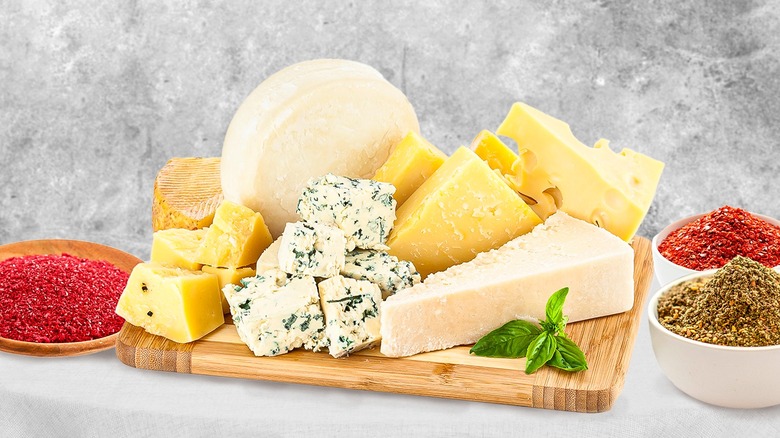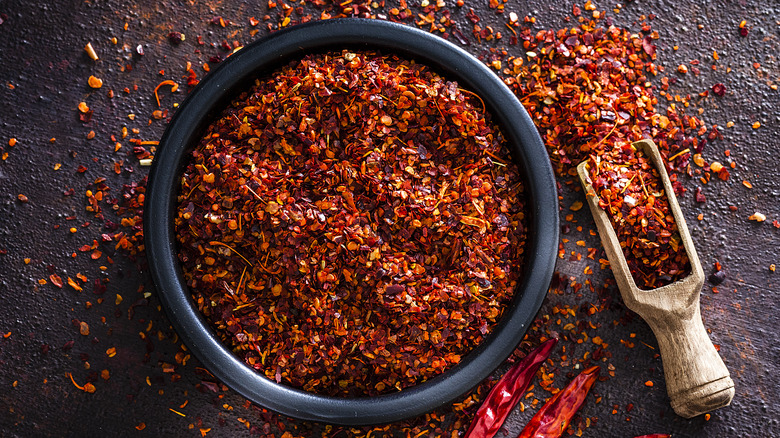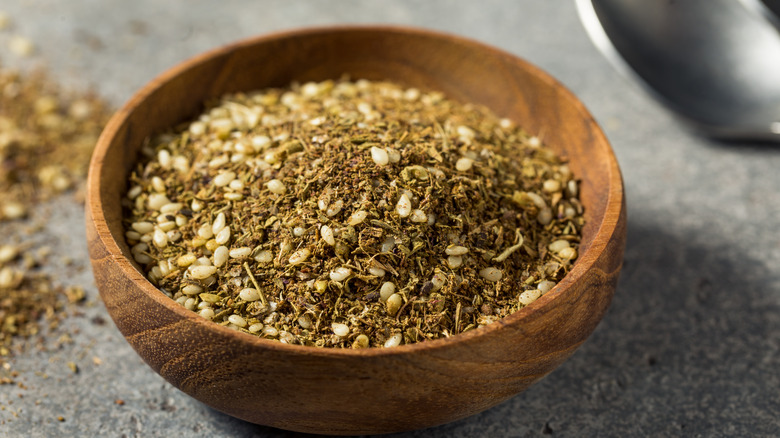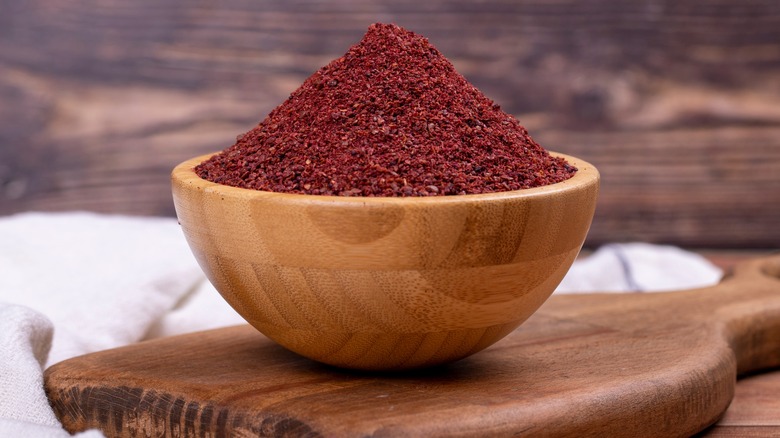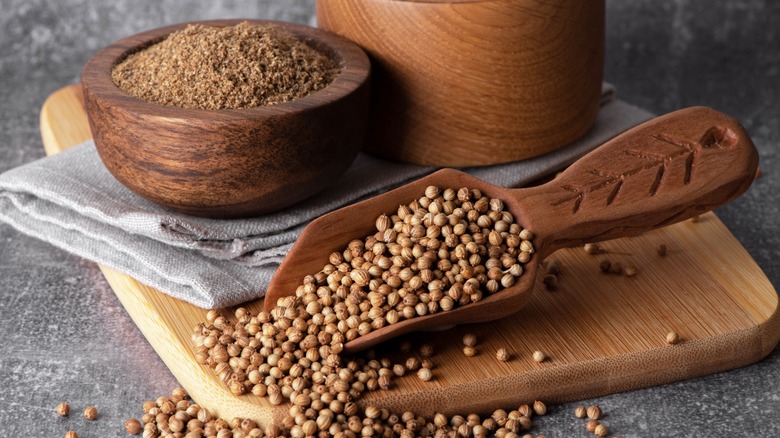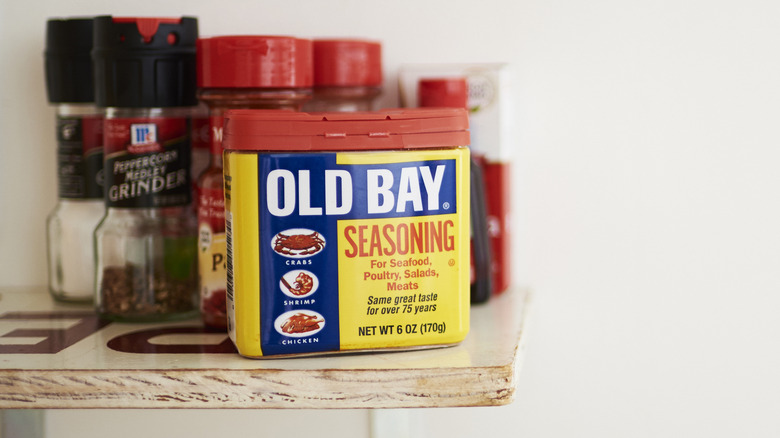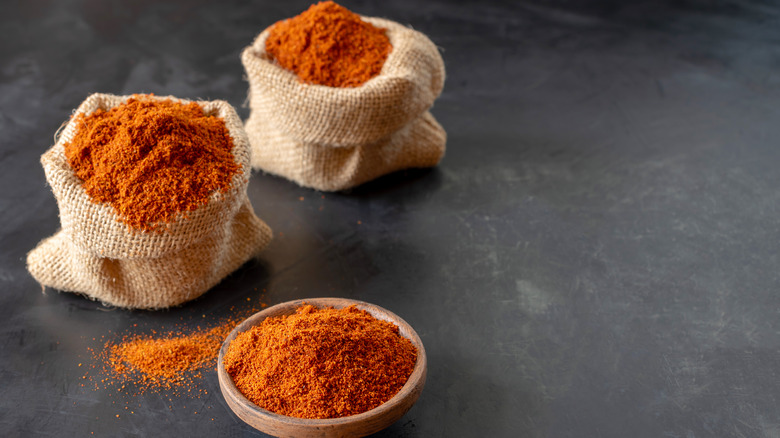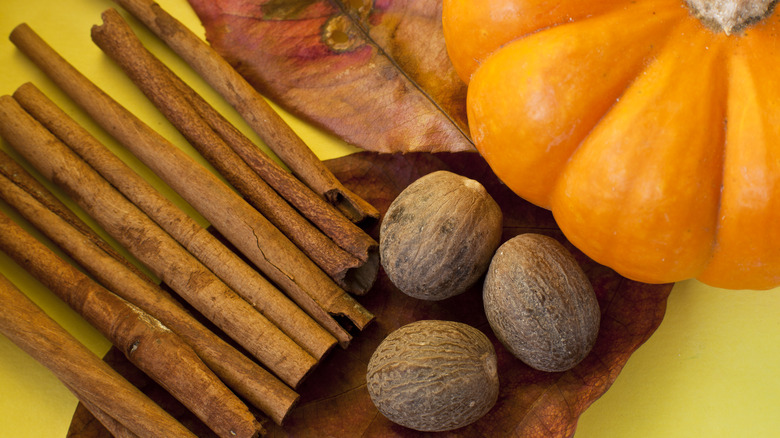7 Spice Pairings To Liven Your Cheese Board
When I was a young cook, I worked in several restaurants with large banquet facilities that required me to do party prep work. That typically included preparing a fruit and cheese platter resembling a Starburst commercial with cascades of fruit intersecting piles of cheese.
They were visually appealing, but it wasn't until several years later that I questioned the logic behind the fruit and cheese combination. Yes, the sugar content and acidity of fruit can complement some aspects of cheese and cut through the richness, but why is it common to pair cheese with sweet accompaniments like chocolate, candied nuts, or jams? Why constrain ourselves to sweet pairings?
I'd been pondering savory cheese pairings, specifically spice-oriented pairings, when I received a press release from the Tillamook County Creamery Association, a farmer-owned dairy co-op on the Oregon Coast, on that very topic.
Tillamook's Executive Chef of Culinary Development, Josh Archibald, demonstrated his pairing abilities when I attended a vertical tasting of their Maker's Reserve cheddars, pairing multiple years' cheeses with specific assortments of savory and sweet elements, as well as wine and cocktails. I wanted to get additional insight to help inform and inspire readers to look beyond the pairings we suggest and provide the tools to enable them to experiment independently. Archibald seemed the right person to enlist for this task.
The basics of pairing
Before taking a step down this path, Josh Archibald emphasizes the importance of the cheese's role in creating pairings. "The cheese is the star," he says. Everything else is there to enhance it, like backup singers or supporting actors.
A basic rule of pairing is to match the intensities of flavors. If you're working with a milder cheese, for example, a young cheddar or mascarpone, the best ingredients to pair it with will be of similar intensity. That doesn't mean bold flavors are off the table, but use them in smaller amounts so they stay in the background. As you go up the scale to more intense, bolder flavors, you can get more muscular with your pairings, as the robustness of the cheese can hold up against bigger-flavored pairings. Gorgonzola, Stilton, or a heavily smoked cheese almost dare you to match it with an ingredient that will stand up to them.
Another consideration is compensating for the cheese's salt content. Archibald believes that some cheeses, like goat cheese, are undersalted. Others, like Asiago, parmesan, or aged cheddar are naturally salty. Consider adding salt to your pairing ingredients for low-salt cheeses to avoid blandness, as salt will intensify the flavor of the cheese and the ingredients, and omitting the salt on those with high amounts.
Gochugaru
Now armed with an understanding of matching flavor intensities and salt levels, let's look at flavor pairings. Gochugaru is a staple in Korean cuisine, appearing in kimchi, soups, salads, or as a stand-alone condiment. It's a chili powder from the red pepper taeyangcho, which boasts a smokey, fruity flavor, registering at 1,500 to 10,000 Scoville units, on par with a jalapeño's 2,500 to 8,000.
Gochugaru is a base element of gochujang, a fermented paste of gochugaru, barley malt, rice, and fermented soybean powder. The latter adds a "funkiness" to gochujang, similar to the background notes of miso. Knowing that gochugaru and funk form a strong pair, this explains why it goes well with blue cheese.
Blue cheeses have plenty of funkiness from the veins of mold running through them and a salty background. Salt is a common ingredient to control fermentation and mold growth and – not coincidentally — is used to regulate gochujang's fermentation. An intensely flavored cheese with funky and salty background notes bode well for gochugaru.
Also, the fruity note from the gochugaru is similar to that of fruits and raisins — common pairing suggestions for blues. Not to mention, blue cheeses have mildly acidic and sweet flavors, which form good combinations with the heat from the gochugaru. Let the slight capsaicin burn come into play by lightly dusting the cheese with gochugaru. For a textural offset, enjoy it with a neutral-flavored cracker.
Za'atar
Let's step back and reimagine a cheese board. It's almost canon that a cheese board contains blocks, slices, or crumbles of cheese with various accompaniments to accentuate them. But nobody says you can't preassemble complementary flavors into something like a baked good or dessert and give it a seat on the board. Josh Archibald's team suggested pairing Tillamook's seven-year-old Maker's Reserve Cheddar with za'atar — in the form of a spiced cheddar scone.
Za'atar is a herb and spice blend found across North Africa and Southwest Asia. Depending on regionality and the person making it, za'atar's ingredients vary. It could contain Syrian oregano or marjoram as a primary flavor. Other ingredients are sesame seeds, thyme, and sumac. The resulting flavors are the minty earthiness of the za'atar and marjoram, the warm, herbal flavors of thyme, the slight nuttiness of sesame seeds, and the bright, slightly acidic citrus notes of sumac.
Now, let's compare that to the tasting notes of an aged cheddar: creamy, berry flavors, roasted nuts, and a peppery finish. Minty and earthy herbs map nicely to the berry flavors, as does the nuttiness of the sesame seeds (think peanut butter and jelly). The mild acidity and citrus notes of sumac cut the richness of the creaminess, and the peppery finish accents the herbaceousness of the za'atar and thyme. The scone provides a vehicle to tie all those flavors together into something cohesive.
Sumac
Sumac, which predates the Roman Empire and plays a role in culinary and medicinal applications, given that it may have antiseptic properties, is the catch-all name of berries that come from the 150 types of sumac plants. Typically available in a coarsely ground form, you may find it as an element of za'atar, finishing dust for hummus with fattoush, or vinegar and citrus substitutes in salad dressings.
When sumac comes up, Josh Archibald thinks of mascarpone — a soft cheese derived from treating warmed cream with either citric or tartaric acid.
The texture is like a less dense, creamier cream cheese and has a rich yet delicate dairy flavor. Cooks frequently pair it with light, citrus flavors like lemon zest to accentuate it and cut a bit of its richness. It also has both savory and sweet applications like the classic tiramisu.
Tiramisu typically consists of layers of coffee-soaked lady finger cookies interspersed with a mascarpone-based zabaglione, brightened with a bit of citrus or citrus zest. For a less sweet version, swap the lady fingers out for shortbread infused with sumac, which goes well with the mascarpone and still gives the zing of citrus notes.
Coriander
Belgian-style beers, including saisons and witbiers, are popular with its Netherlands neighbors. Both beer styles have a common, typical flavor additive that brings about their distinctive tastes: coriander.
Coriander is the seed of the cilantro plant. The leaves have a green, herbaceous flavor with trace notes of pepper that some people with a particular genetic arrangement find disagreeable and soapy-tasting due to their ability to detect certain aldehydes in the leaves. Coriander doesn't have that green, herby characteristic and leads with an almost lemony citrus quality with notes of black pepper.
Gouda is the most produced and best-known cheese in the Netherlands. Its roots date to the 1100s and are firmly embedded in the culture. Young gouda, aged between one and nine months, is soft, creamy, and sweet. As gouda ages after nine months, it takes on a denser form, similar to parmesan. Its flavor profile transforms to caramel with nutty tones and cheese crystals — white deposits formed by a chain of chemical reactions — are distributed throughout.
This popular cheese pairs with the popular Belgian beers. We know that sweetness and heat work well together, so the sweet gouda and the peppery elements of the coriander seeds track. Citrus and caramel are also matches. A light dusting of coriander over the gouda is more than enough to make this pairing work.
Old Bay
When Josh Archibald suggested Old Bay seasoning, it gave pause. Old Bay started as a seafood seasoning. How does that translate to cheese? No one other than the manufacturer knows exactly what's in Old Bay besides the confirmed ingredients of paprika, peppers, and celery salt. Recipes that mimic Old Bay include spices like dried mustard, cardamom, mace, cloves, cinnamon, and ginger.
Archibald suggested pairing Old Bay with Fontina, a cheese frequently described as mild, creamy, nutty, rich, mushroomy, and vegetal. None of Old Bay's primary ingredients — peppers, paprika, celery salt — would clash with Fontina's descriptors. Dried mustard also blends with the cheese's vegetal, mushroomy, and nutty elements. The other ingredients found in Old Bay copycat recipes are common in savory spice blends, like masala or chai. Chai latte? There's your creamy element. Likewise, the flavor of spiced nuts came to our minds. Mushrooms pair well with those Old Spice flavors, too.
Fontina is more delicate than blue cheeses or gouda, so you may want to avoid applying the Old Bay directly onto the cheese, unlike the gochugaru or coriander suggestions. With Fontina's medium-flavor intensity and softer texture, you may also want to steer away from bread or baked goods as a vehicle for the Old Bay. Instead, liberally apply the spice blend onto buttered popcorn or toasted cashews and add them to the cheese board. It's a delivery method that provides textural contrast to the Fontina's creaminess.
Berbere
Berbere is an ancient spice blend dating to 5th century Ethiopia, where it's so entrenched that it has defined the cuisine. The exact makeup of berbere varies, but in general, it contains long peppers, cinnamon, korarima, fenugreek, red chili peppers, allspice, cardamom, peppercorns, ginger, cumin, coriander, paprika, nutmeg, ajwain, and cloves. Its red coloring would lead one to believe berbere is a hot spice, but that's not the defining characteristic of it. Although the long peppers and chilis bring heat, the blend leads with rich notes of citrus, smokiness, sweetness, earthiness, and savoriness.
Berbere seems like a big-bodied blend; you might expect an equally muscled cheese to pair it with. Instead, balancing a nuanced blend of spices with an equally nuanced cheese is the goal here. Comté cheese has a reputation for pairing with almost anything: red or white wine, beers, fondues, and salty meats. But its smoky, sweet, nutty, and fruity flavors almost scream for a worthy companion to reach their full potential.
Smoke on smoke is great when applied judiciously, and Comté's nutty and sweet elements dance nicely with the sweet citrus elements of berbere. The savory earthiness of the spice lifts the nutty flavors of the cheese. You could apply a light sprinkling of the berbere directly to the cheese or toast some bread with the spice blend to deliver texture on top of flavor.
Pumpkin spice
Pumpkin spice is something typically reserved for sweet dishes. However, Josh Archibald suggests it pairs well with cheese in savory applications. Pumpkin spice isn't sweet in its natural environment, and its primary components, cinnamon, nutmeg, allspice, cloves, and ground ginger, are found throughout this list in savory spice blends. Suppose you don't want to purchase a special spice or are not feeling adventurous in adding multiple flavor layers. In that case, you've probably already got pumpkin spice, or the makings of it, in your spice cabinet.
The soft texture and creaminess of a triple creme cheese, such as Camembert or brie, are an excellent match for pumpkin spice. Pairing the creaminess with the spice is natural and best illustrated with the pumpkin spice latte. The typical brie flavors, slightly nutty, fresh mushrooms, and melted butter, all align with the pumpkin spice latte model in a savory version. Triple cream cheeses typically have a low salt content, so bringing something salty into the mix will amplify the blending of the cheese and spices. Because of the soft nature of the cheese, something with crunch is to provide a textural contrast. Toasted pumpernickel rounds or corn chips dusted and baked with pumpkin spice provide the crunchy element and a vehicle for the spice. The sweetness and caraway notes of pumpernickel are bonus flavors, as is the dry corn flavor from the chips. For those craving a bolder cheese flavor, pumpkin spice also works well with the creaminess of taleggio.
